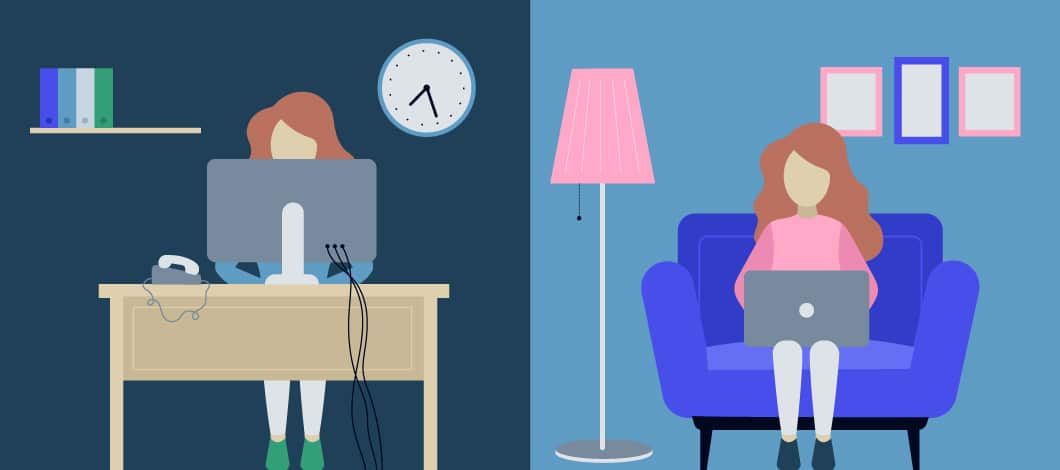As lockdown restrictions lift, business owners are wondering about the future of office space.
Here are 10 trends to expect:
1. Many Remote Workers Will Continue to Telecommute
One of the most fundamental changes to the post-COVID office will be the reduction of the number of employees who work on-site full-time. The future of office workers will be increasingly remote, a variety of data indicates.
A significant number of employees prefer remote work to on-site work. A Gallup poll conducted in September 2020 found 35% of employees who had been working remotely would like to continue to do so after the lockdown ends. An equal number wanted to return to the office, underscoring the division of sentiment on the subject.
Recognizing this divided attitude, real estate developers are preparing for offices with downsized on-site workforces, a September 2020 survey of global-level real estate executives by real estate service provider Coldwell Banker Richard Ellis (CBRE) found.
According to the survey, 49% of organizations are expecting 25% to 75% of their employees to be full-time remote workers in the wake of the pandemic. Another 25% expect less than 25% of the employees to work remotely full-time. About 14% expect less than 10% of their employees to be full-time remote workers. While these numbers may shift as more workers actually return, they indicate a trend that is likely to affect on-site staff size.
2. Companies Will Adopt More Flexible Remote Work Policies
As businesses adapt to the increased use of remote labor, employers are shifting toward policies that offer employees more choice about their work location and hours. CBRE’s September 2020 survey found that 73% of organizations expect to offer workers more choice about where they work and when, an increase from 61% in June.
Employers are debating what type of balance between on-site and remote work they should offer. Most employers prefer that employees work on-site several days a week, a survey by professional services provider PricewaterhouseCoopers found. When U.S. executives were asked how often they think employees should work on-site if COVID-19 were not a concern, 29% said 3 days a week, while 21% said 5, 18% said 4, and 15% said 2. Employers find coming to a physical office valuable for collaboration and building relationships.
3. Businesses Will Diversify Their Locations
The shift to a blend of on-site and remote work will encourage businesses to split their operations between central hubs and distant spokes. This trend predates the pandemic, but is being accelerated by it.
The rise of high-tech, knowledge-based firms has drawn companies to large cities and tech hubs where young talent pools are located, such as New York, Los Angeles and San Francisco. Long-term statistical tracking by University of Toronto researchers shows that nearly 90% of Fortune 500 headquarters are now located in cities with metro populations of 1.3 million or more.
However, rent in these locations is high, and with the rise of remote work options, many workers with families and older workers are relocating to suburbs and smaller cities. This counter-balances the trend toward urban centralization. The net effect will promote a blend between central hubs that house company headquarters and peripheral satellites to support remote workers.

4. Companies Will Opt for Shorter Office Leases
The remote migration and economic uncertainty fueled by COVID-19 have promoted a trend toward shortened office leases. Faced with the unknown duration of the pandemic and economic downturn, companies nearing the end of their leases have opted for lease extensions or renewals rather than seeking out new office space.
During the first 5 months of 2020, the average lease term fell 15% to 7 years, according to real estate service provider Jones Lang LaSalle. This has been accompanied by an increase of renewals from 29% of leases to 51%. This trend, coupled with growing remote labor forces, will tend to reduce demand for office space in downtown areas, leading some commercial office space to be converted to other uses such as residential housing or ecommerce fulfillment centers.
5. Some Offices Will Move Into Coworking Space and Residential Real Estate
Labor migrating out of downtown office space has other options for relocating. One is moving into coworking spaces, where multiple companies share space.
Coworking space usage suffered a temporary decline at the height of the pandemic, with global usage dropping 50% in some areas in March 2020, according to market research firm ResearchAndMarkets.com. However, the market is projected to recover by 2023, when it will reach a value of $11.52 billion and a compound annual growth rate of 11.8%.
Some offices also are moving into residential areas and other unconventional spaces such as retail stores and hotels. In recent years, an increasing number of multifamily apartment providers have added work spaces and meeting spaces to residential buildings. Co-living provider Common, which had been preparing to roll out “Remote Work Hub” hybrid apartments and office spaces throughout the U.S. before COVID-19 struck, plans to break ground in five cities after the pandemic subsides.
6. Office Design Trends Will Promote Better Ventilation
Office layout changes built for safety will shape the design of the post-lockdown workspace. One of the most important safety precautions for preventing the spread of coronavirus and other health risks in indoor spaces is proper ventilation, advises the Centers for Disease Control. Good ventilation can reduce the concentration of viral particles and the risk of inhalation.
Businesses can use a number of strategies for improving ventilation, including opening windows, blowing fans in safe directions, increased airflow and central air filtration. One of the most effective strategies is displacement ventilation, which draws exhaled air out through vents at the top of a room while pumping filtered air in through vents near the floor. A University of Cambridge study found that a properly designed displacement ventilation system was the most effective method for dispersing coronavirus particles in indoor areas.
7. Office Layout Changes Will Promote Social Distancing
Another important imperative is designing workspaces that allow office social distancing in the event of a resurgence of COVID-19 or the outbreak of another pandemic. Post-lockdown layouts will promote greater spacing and safety barriers between workers.
One challenge will be building safety features into open-plan offices that lack walls and partitions between workspaces. Proper ventilation is one key to protecting open-plan office workers from coronavirus, says Kevin Van Den Wymelenberg, director of the Institute for Health in the Built Environment, a University of Oregon research center devoted to developing healthier architectural designs. Other strategies that can promote social distancing in open floor plans include decreasing the number of workers per room, reducing the number of workers per table and providing open breakout spaces with alternative seating for collaboration.

8. Virtual Meetings Will Support Social Distancing
Virtual meetings will help promote social distancing in the post-lockdown workspace. The pandemic sparked a surge in business use of virtual conferencing technology. Videoconference services provider Zoom experienced a revenue increase of 355% year-over-year in the second quarter of 2020.
This rapid growth will level off this year as the market stabilizes, but will continue to rise through 2025, projects market research provider Reportlinker. From $6.03 billion in 2021, the global market will grow to a value of $8.67 billion by 2025, representing a compound annual growth rate of 9.5%.
9. Employers Will Strive for a More Sterile Office Environment
Another important preventive coronavirus office policy in the post-lockdown workspace will be taking steps to promote a more sterile office environment.
One step employers can take is selecting finishes and furniture that are easy to sanitize. Self-cleaning surfaces that have moisture-repellent and particle-disintegrating properties have been under development for some years. Since the pandemic began, researchers have accelerated the production of self-cleaning door handles and handrails that are resistant to COVID-19.
Handwashing is another important weapon against the coronavirus and other germs. Many offices only have washing facilities in bathrooms, but installing dedicated handwashing and hand sanitizing stations can promote better office safety. Some automated hand sanitizing products include digital sensing technology that helps employers monitor and enforce hand hygiene policies. No-contact technology such as touchless doors and sinks will play a role in promoting office sanitation.
10. Office Vaccination Policies Will Find a Compromise With Worker Rights
Some employers are implementing mandatory vaccination policies as workers return from lockdown. Employers pursuing this strategy should be aware that the Equal Opportunity Employment Commission (EEOC) has issued guidelines for businesses on how to keep vaccination policies in compliance with antidiscrimination laws.
The EEOC emphasizes that employers must recognize exceptions for employees who aren’t able to receive vaccinations because of lack of availability, health or disability issues or religious objections. Additionally, employees are eligible for compensation for time spent getting vaccinations, and some states such as New York, have laws making employees eligible for paid time off following vaccinations.
Employers who ask employees to provide documentation of vaccinations should be sure to comply with privacy laws such as the Health Insurance Portability and Accountability Act. Because the legal ramifications of mandatory vaccination policies can be complex, employers should consult an attorney who can provide advice on compliance with federal, state and local laws.
Get Your Office Ready for the Post-Lockdown Future
The post-lockdown office space will emphasize remote work policies, diversified locations, alternative rental arrangements, and workplace safety measures. Policy updates will play a role in implementing some of these changes, but in some cases physical upgrades will be necessary.
If you need to invest in office upgrades or safety equipment, consider a commercial loan or other small business financing options.










